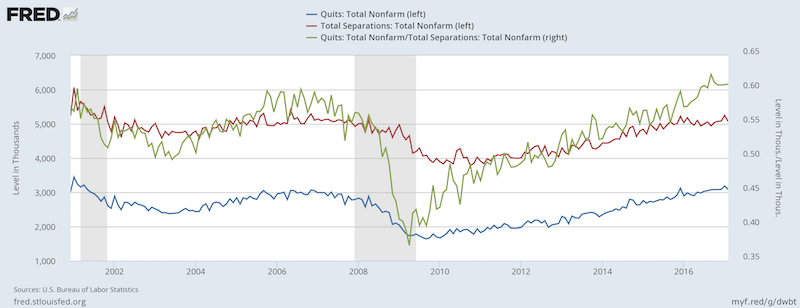For quickly taking the pulse of the economy (vis a vis the job market), nothing beats JOLTS from the Bureau of Labor Statistics. A relatively new offering, the Job Opening and Labor Turnover Survey gives a surprisingly detailed look at the undercurrents in the job market.
When we pull that data down, the first thing we check is a basic ratio: the number of (non-farm) quits versus the total number of people who left a job. In February, the last month data is available, that number was 60.82%.
Confidence in the Job Market
In theory, a strong quit:total separation ratio is an excellent sign of confidence in the job market. Although you can't map directly from the ratio to an exact emotion, the relative level of voluntary vs. non-voluntary separations suggests how confident people are in their ability to find a new job.
And that pattern has held - even in the very short history of the survey:
Through the Great Recession, you can see that ratio fell off to an extreme level. For a few months, less than 40% of job separations were quits. The blue and the red levels are absolutes - you can see that quits (the blue line) declined rapidly during the recession. The slope on the red line (separations) wasn't as negative, as employers laid off workers in much greater numbers than in previous months.
Interestingly, we're now seeing the highest ratio in the history of the survey. The ratio hasn't been under 60% since May, 2016 when it still read a healthy 58.9%. The number has suggested that people in the workforce are currently quite confident in their job prospects (even euphoric).
Could This Overview be Masking Anything?
While the Quit:Separation ratio is an excellent look at the job market's confidence level, it doesn't pick up everything. Stories and studies [pdf] abound about the gig economy and issues for many former workers. Folks who are having an issue re-entering the workforce wouldn't show up in this data. All we can speak to is how people who were already attached are feeling.
So yes, this data is good but naive. You can't map exactly from here to there, but you can say one thing with relative confidence. People currently in the job market are feeling confident.
What's your favorite quick measure of the job market? Is this a good one? How would you improve it?

